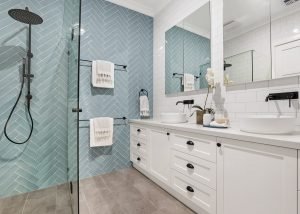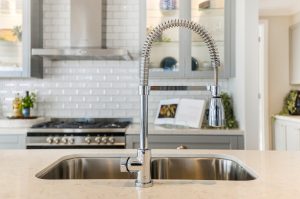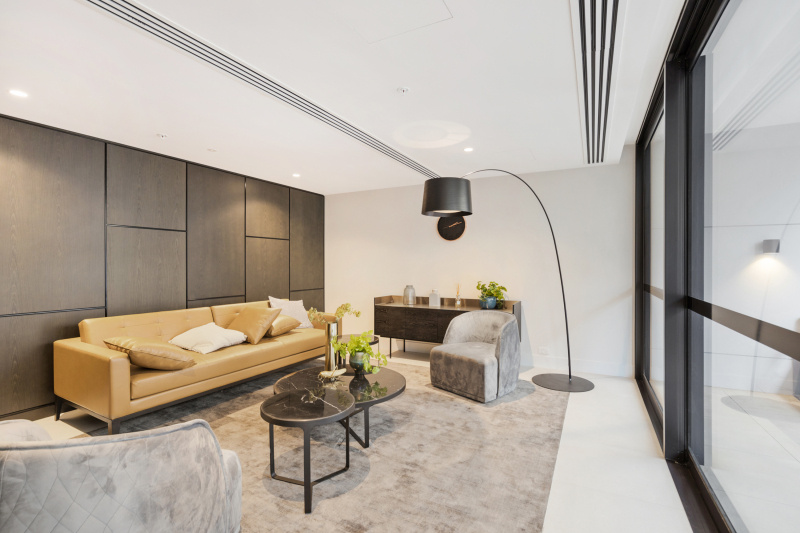When styling a house for sale, focal points are important because they tell the buyer where to look and what to concentrate on. A buyer will notice the positive attributes of your home when staging is used correctly, and just as importantly, they will not remember the less attractive aspects that all homes have.
Contrary to what many people think, it is not logic or reason that prompts people to buy a home, it is an emotional process. It is so much easier to elicit THE FEELING from customers to make them want to buy when your home is beautifully decorated and has good focal points. That is what home staging is really all about.
 Creating Fixed Focal Points in Your Home for Sale
Creating Fixed Focal Points in Your Home for Sale
Only one focal point should be used in each room; the one place that attracts the eye instantly and naturally. Things like fireplaces, dramatic light fixtures, built-ins, contrasting kitchen islands, and other architectural features are all examples of fixed focus points. These are the best focal points since they are also some of your home‘s permanent features, so buyers will know they’ll be getting them as a part of the deal.
Using Artwork as a Focal Point to Boost Your Home’s Sale Price
If the room lacks architectural detail, great imagery can be used to build a focal point. Artwork hung over a sofa, or a bed provides a focal point and also helps to create a sense of style.
Making it big is the secret to using art as an important focal point when styling a house! You do not need 100 trivial things; you just need one big thing. How big? The artwork should be 2/3 the width of whatever it is hanging over for typical rooms. This may be one big piece grouped together or 2-3 smaller pieces.
 Accessorise to Make Big Difference with Small Touches
Accessorise to Make Big Difference with Small Touches
This may seem a little strange, as the common – and smart – home staging advice you will receive at the start of the project is to depersonalize the space and remove many of your possessions to the point that your home feels a little empty.
So, once that’s done, yes, a professional home stager will add some accessories back into the space. Sounds crazy, but there is an art to being a home stylist. If you look at TV show sets, they’ve all been styled to help strengthen the mood of the show or character. When we are looking at using accessories and art, it is all to strengthen the mood of “Contemporary, Stylish, Elegant Home” or whatever look you are going for to convince buyers to choose your home.
Here is the why and how accessories work to present your home better than your non- or poorly- staged competition:
1) Bigger is Better: Often people add these large groups of very little things that tend to look quite messy in listing photography. Use accessories to make a strong style statement. Fewer, larger, strategically placed items have the best impact.
2) Think in Twos and Threes: If you see an accessory that comes in 2-3 sizes, grab it. It always looks good. Vases, candlesticks, decorative boxes, etc.
3) Color Story Counts: If your walls and/or furniture are colorful, stick to white and silver accessories so that they will pop off the walls. If your walls are exceptionally light, use accessories to help strengthen your accent color; apple green, blue or red are great accent colors. Pick one color and stick with it.
4) Mix Textures: You can add additional aesthetic appeal by mixing something shiny with something rough, ceramic with something organic. Try to mix materials when arranging.
The homes that sell the best are the ones that best meet not only the needs, but the desires and wishes of the target buyer. Decor and styling absolutely tell the buyer that your home will offer that easy, elegant, and serene lifestyle that almost every buyer is longing for.
 Using Natural Light as a Home Staging Focus in Your Home for Sale
Using Natural Light as a Home Staging Focus in Your Home for Sale
One other focus that you should keep in mind when styling your home is highlighting natural light.
One of the most beneficial features to have in your home is an abundance of natural light. It is an ideal tool to make your home feel open, warm, and inviting, which happens to be at the top of the list of desired house characteristics of most prospective home buyers!
Not all houses or rooms are blessed with or constructed with a stream of natural light in mind. Fortunately, in their absence, there are some clever ways you can make the most of the rays which do stream in and offer the illusion of more light!
Paint with Colors That are Bright
The lighter the hue, the better when choosing an interior paint color for dim spaces. Obviously, white will be your brightest choice, but going for a cream or off-white shade will keep the room warm.
Other cool tones like a soft gray or a soothing blue will help make your space soft and friendly while still adding the brightness you need. These are also great colors for staging a home office space, as they are considered hues that add concentration and reduce stress.
To maximize the natural light in your house, don’t just concentrate on the walls, either. Paint your eaves and ceilings white so that they reflect more light into your rooms. To achieve a greater illusion of light in very dim rooms, select a ceiling color a few shades brighter than the walls.
 Keep Home Spaces Open
Keep Home Spaces Open
By blocking their best light sources, many people cut off the flow of natural light through their homes. Don’t make this mistake! To prevent obstruction of sunlight and allow the light to reach more of the room, move your furniture a few feet away from any glass doors and windows, particularly if you have a home showing coming up.
Your windows are your number one natural light source. Stop covering them with thick curtains or drapes and opt for a breezy material like cotton or linen instead. Find blinds that also give you enough control to filter in more light. And don’t forget to keep the shrubbery trimmed and tidy outside your windows too!
Australian Property Stylist Directory
If you would like to get a Property Stylist to chat with you about how they can style a house for sale, then take a look at the comprehensive Directory of the Property Stylists nearest you.

